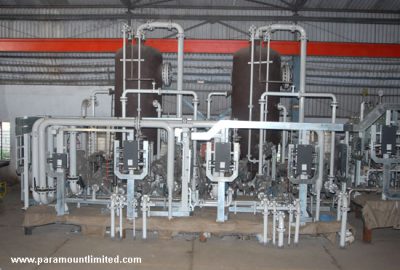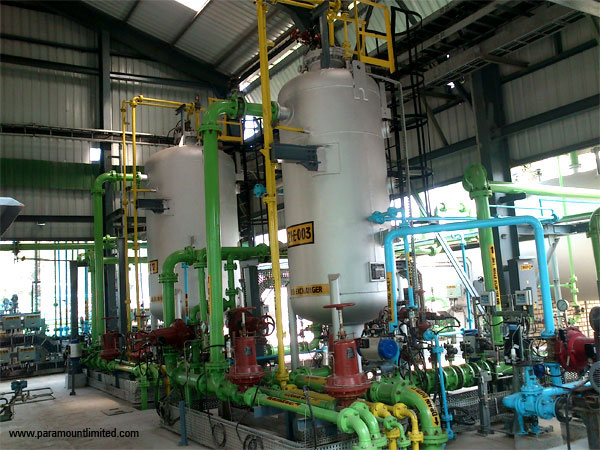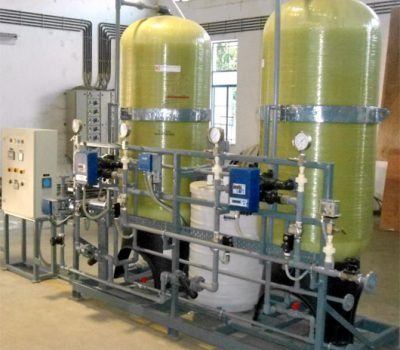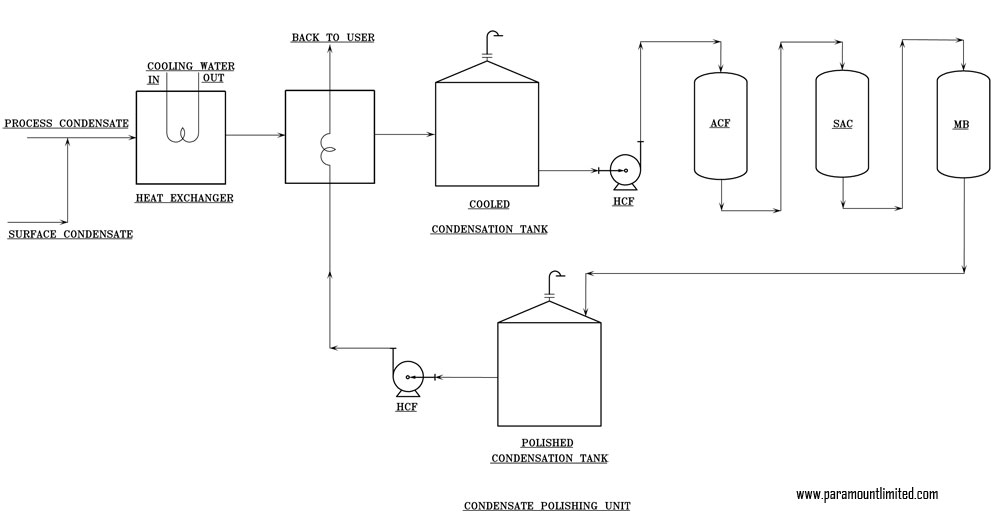Resin Based Systems
Ion Exchangers
Ion Exchangers are used for various applications. In water treatment, it is used for softening & demineralising (removal of salts) for applications such as High Pressure boiler feed, Electronic Industries etc.
Paramount Limited designs, manufactures & installs Ion Exchangers of large capacities to small units as per requirement in manual & semi-automatic operation; tailor-made to the requirement of the customer.
Paramount designs, manufactures, deliver DM Water Plants for various applications including boiler feed water for high pressure boiler in the power station, with the quality standard required for the purpose.

Paramount can deliver these in various combinations for specific requirements, tailor made on a turnkey basis, or as package units depending on the size & logistics for any flow capacity. Paramount designs three plants in manual or semiautomatic made based on PLC or DCS operations.
The common configurations are shown below. The largest installation delivered by paramount is 600 m3/hr (4×150 m3/hr chains) having water quality of silica less than 10ppb and Conductivity of less than 0.1 micromole/cm.
Demineralization is the term used for removal of the Dissolved Salts from the Water. The source of water can mainly be classified into two groups.
• Surface water – Rivers, streams, ponds, lakes, reservoirs, etc.,
• Underground water – Open wells, tube wells, springs, etc.,
The salts leached out from the earth and the rocks get dissolves in the water. So the nature of salts and the contaminants in the water depends on the surroundings. For example, where the water flows through lime stone and gypsum rocks, the hardness will be high. Hardness is caused due to the presence of Calcium and Magnesium.
So every water is different in their salt content and the type of salt. The salts deposit on the surface of the container and acts as an insulator. Greater the temperature of the water greater is the problem. These deposits called “scales” are very hard and difficult to remove. When scales are formed it affects the heat transfer and at a certain stage the container is damaged.
Hence, the water requires to be treated before it is used for a particular purpose. Depending on the end use, various economical treatments are possible.
The salt content can be reduced to near zero (Trances) by proper selection of the process & method of Regeneration.
By adopting Counter current regeneration of cation Exchanger and Anion Exchanger, We can get superior quality of water at the outlet of Anion Exchanger and pass the Anion treated water through the Mixed Bed polisher. We can get the desired quality with Conductivity less than 0.1 Micromo / cm and Silica less than 0.01 ppm as SiO2.
De-Mineralized Units
Paramount designs, manufactures, deliver DM Water Plants for various applications including boiler feed water for high pressure boiler in a power station, with the quality standard required for the purpose.
Paramount can deliver these in various combinations for specific requirements, tailor made on a turnkey basis, or as package units depending on the size & logistics for any flow capacity. Paramount designs three plants in manual or semiautomatic mode based on PLC or DCS operations.

The common configurations are shown below.
The largest installation delivered by paramount is 600 m3/hr (4×150 m3/hr chains) having water quality of silica less than 10 ppb and Conductivity of less than 0.1 micromole/cm.
Demineralization is the term used for removal of the Dissolved Salts from the Water.
The source of water can mainly be classified into two groups.
• Surface water – Rivers, streams, ponds, lakes, reservoirs, etc.,
• Underground water – Open wells, tube wells, springs, etc.,

The salts leached out from the earth and the rocks get dissolved in the water. So the nature of salts and the contaminants in the water depends on the surroundings. For example, where the water flows through lime stone and gypsum rocks, the hardness will be high. Hardness is caused due to the presence of Calcium and Magnesium.
So every water is different in their salt content and the type of salt. The salts deposit on the surface of the container and acts as an insulator. Greater the temperature of the water greater is the problem. These deposits called “scales” are very hard and difficult to remove. When scales are formed it affects the heat transfer and at a certain stage the container is damaged.
Hence, the water requires to be treated before it is used for a particular purpose. Depending on the end use, various economical treatments are possible.
The salt content can be reduced to near zero (Traces) by proper selection of the process & method of Regeneration.
By adopting Counter current regeneration of cation Exchanger and Anion Exchanger, We can get superior quality of water at the outlet of Anion Exchanger and pass the Anion treated water through the Mixed Bed polisher. We can get the desired quality with Conductivity less than 0.1 Micromo / cm and Silica less than 0.01 ppm as SiO2.
Water Softening Units
SOFTENING is a process of converting ‘Hard’ water to ‘Soft’ water.
Hardness in water is mainly due to the presence of Calcium and Magnesium.
These ions are referred to as the Hardness.
The harmful effects of the presence of Hardness are that when the water is heated, scales are deposited on the contact surface of the container which is difficult to remove. This will act as insulation preventing efficient heat transfer and damage the container due to over heating. There is a loss of fuel also.
Other harmful effects of the hardness are the consumption of soap / alkali used in washing, dyeing, and similar applications in textile industries. Heavy consumption of soap will be there without satisfactory washing in laundry use.

Earlier methods of removing / reducing the hardness is by cold lime soda process, hot lime soda process, Sodium Zeolite process using a material such as green sand and carbonaceous material.
But after the advent of the synthetic Ion Exchange Resin, the use of the other processes have become unknown.
In this process of Ion Exchange Resin, the Calcium and Magnesium ions are replaced by Sodium ions.
The Resins are synthetic material in spherical bead form porous in structure and adsorb the ions.
For the Softening process, Cation Resin is used and the resin is regenerated with Sodium Chloride (NaCl), generally termed as Common Salt.
When the Sodium chloride is passed through the resins, the sodium ion is adsorbed by the resin. This process is called the process of regeneration.
When the water containing the hardness is passed through this regenerated resin the resin adsorbs the Calcium and Magnesium ions in the water and gives out the Sodium ions which it had adsorbed during the regeneration process. Thus, the water will have ions of sodium in place of Calcium and Magnesium. The water thus becomes Soft.
We, at PARAMOUNT LIMITED, design and supply softeners of various capacities starting from a few liters/hr to several hundred cubic meters/hr.
We have standard models of softeners available with short deliveries for capacities up to 30 m3/hr.
We design and supply Softeners to your specific requirements.
Condensate Polishing Unit
The condensate polishing units are used in refineries and petrochemicals, fertilizer to polish the process condensate and surface condensate for reuse. During the process, the condensate picks up contaminant like Iron, Copper, Oil, Silica etc., and therefore, needs to be treated by mixed bed polisher.
Paramount Limited has supplied offline CPU for Refineries, Fertilizer plants, Petrochemical Industry. Paramount Limited has so far done large condensate polishing unit of 2 x 250 m3/hr.
The condensate polishing units are also used in refineries and petrochemicals, fertilizer to polish the process condensate and surface condensate for reuse.

During the process, the condensate picks up contaminant like Iron, Copper, Oil, Silica etc., and needs to be treated by mixed bed polisher.

The condensate polisher typically consists of a heat exchanger activated carbon filter and mixed bed polisher. The heat exchanger is used to reduce the temperature to about 40º-50º C, due to the limitations of temperature for anion exchange resin. In some cases, a cation exchanger is also installed preceding the mixed bed exchanger. After the mixed bed polisher, the condensate is sent back for reuse.
Paramount has so far done large condensate polishing unit of 2×250 m3/hr.
The common configuration is shown below.

Contact Us At
Address
Paramount Limited, Paramount Complex, Near Natubhai Circle, Race Course, Vadodara, Gujarat - 390007
Phone Number
Vadodara: +91-0265-2397111
+91-0265-6603700
New Delhi: +91-11-26186525, 26186369
Mumbai: +91-22-24078105
Email Address
Vadodara: sales@paramountlimited.com
New Delhi: delhi@paramountlimited.com
Mumbai: mumbai@paramountlimited.com

